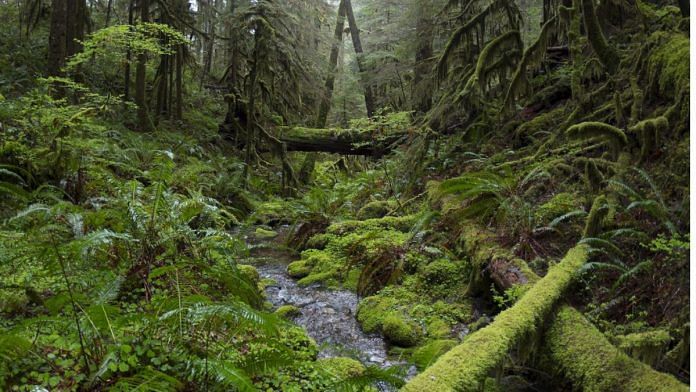They are the world’s oldest and most biologically diverse terrestrial ecosystems. They are home to some of the world’s oldest and largest trees. The world’s longest river and largest drainage basin flows right through them.
But if those often-repeated nuggets aren’t enough to convince you of their importance, here’s five more rainforest facts you may not have heard.
1. Temperate rainforest are the densest store of above-ground carbon in the world
When we think of rainforests, our minds tend to turn to the great tropical rainforests of the Amazon or Congo. Far less talked about are temperate rainforests, found mainly in coastal and mountainous regions where temperatures are less sticky.
Compared to regular forests, rainforests tend to be composed of tall, evergreen trees, and have a high amount of rainfall – more than 80 inches a year. But there is nothing to say they have to be in hot places.
Temperate may not be as biologically diverse as their tropical counterparts, but the slower growing, longer living plant environment makes them the densest store of above-ground carbon in the world. Giant Redwoods in the Pacific Northwest are the world’s oldest and biggest trees, capturing more carbon than any other species.
One thing they do unfortunately have in common with tropical rainforests is deforestation – temperate rainforests are thought to be more threatened than tropical rainforests.
In the UK, research suggests that the temperate rainforests which used to mostly cover the west coasts have the potential to be partially restored. The remaining forests could double in size in a generation if they were allowed to naturally regenerate, Guy Shrubsole of the Lost Rainforests of Britain Campaign, told The Guardian.
2. Rainforest biomimicry is informing our engineering and technology
We all know rainforest fauna and flora has had a huge influence on biomedical science, helping us develop new treatments for diseases like cancer. In fact a quarter of all modern medicines come from tropical forest plants. But it is also having an impact on physical sciences, engineering and technology.
Inspired by the unique way pitcher plants trap insects, researchers at AdaptiveSurface Technologies have created a repellent surface coating for containers. Snake skin has inspired more grippy shoe soles which could reduce the risk of falling among older adults. Geckskin mimics gecko’s feet to create reusable tape which sticks to multiple surfaces without damage. Chameleons have inspired vibrant new inks for 3D printing. And ants in the Amazon have inspired algorithms for self-driving cars.
3. Rainforests are such an effective carbon capture mechanism, we’re trying to fake it
The world’s forests sequestered about twice as much carbon dioxide as they emitted between 2001 and 2019. And tropical rainforests are the most important carbon sink of all – collectively sequestering more carbon than temperate or boreal forests.
But deforestation and declining rainforest health are having a significant impact on their effectiveness as a carbon capture mechanism. Of the world’s three largest tropical rainforests, only the Congo has enough standing forest to remain a strong net carbon sink.
As a way to remove carbon from the atmosphere, these nature-based solutions outstrip any engineered offering currently available. So successful are they, scientists are working on various ways to artificially reproduce photosynthesis. These include creating enzymes with artificial components and new materials inspired by lichen which combine fabricated polymers and loofah sponges.
This underlines the importance of conserving fragile rainforests, and restoring damaged ecosystems, benefitting both biodiversity and carbon sequestration.
4. Indigenous peoples are the most effective stewards of tropical rainforests
Eighty per cent of terrestrial species call the tropical rainforest their home – but it is not just dense in animal and plant life. The Amazon alone is home to 30 million people and, according to the Coordinator of Indigenous Organizations of the Amazon Basin, about 9% (2.7 million) of its population is still made up of indigenous people. This includes 350 different ethnic groups, more than 60 of which are largely isolated.
The region is also home to multiple ancient settlements, suggesting that many people settled along the entire southern rim of the Amazon and managed the rainforest.
Indigenous peoples’ and local community lands cover a third of the land on Earth – and remarkably 91% of these lands are in good or fair ecological condition. This is testament to their careful stewardship, balancing the needs of humans and nature.
We can take lessons from these indigenous peoples in our own efforts to conserve and restore these ecosystems.
5. We keep cutting rainforests back for farming – but the soils they grow in are actually very poor
Agriculture is the largest single cause of deforestation. This includes large-scale livestock ranching and plantations growing soy, palm oil, rubber, coffee, tea and rice.
As well as the environmental impact of deforestation, there is also a huge social impact, with concerns about working conditions in some areas.
However, many of the world’s rainforests are considered ‘wet deserts’, in that they grow on extremely poor soils, low in nutrients and are therefore not that suitable for agricultural use.
The reason the forests are so lush is in fact the rapid nutrient cycling – the goodness from decaying wood and leaves is processed very efficiently by bacteria, fungi and termites. This recycling happens so quickly that few nutrients ever reach the soil, leaving it nearly sterile.
But deforestation is leading to the savannization of the Amazon, according to the Brazilian scientist and meteorologist Carlos Nobre, who has spent three decades fighting for the rainforest. Only the double impact of reaching zero deforestation, alongside limiting global warming to 1.5C, can prevent savannization from happening, Nobre told Mongabay. “That’s why this immense region is very close to its point of no return.”
This article was originally published in the World Economic Forum. Read the original article here.
Also read: It’s good to avoid weight gain during holidays. But why you shouldn’t fret about it too much



